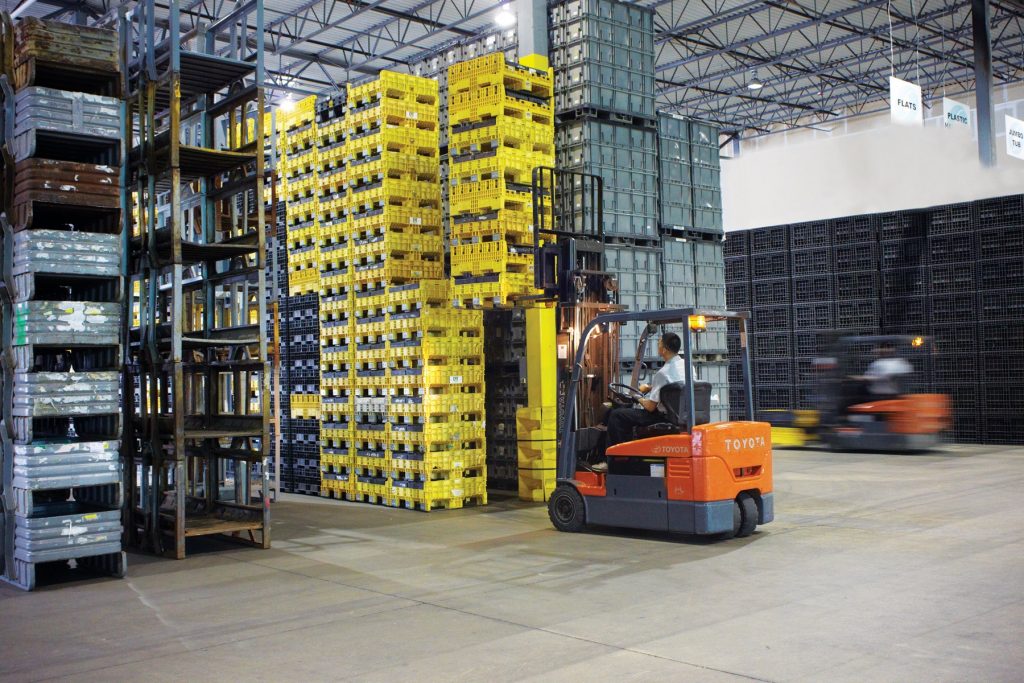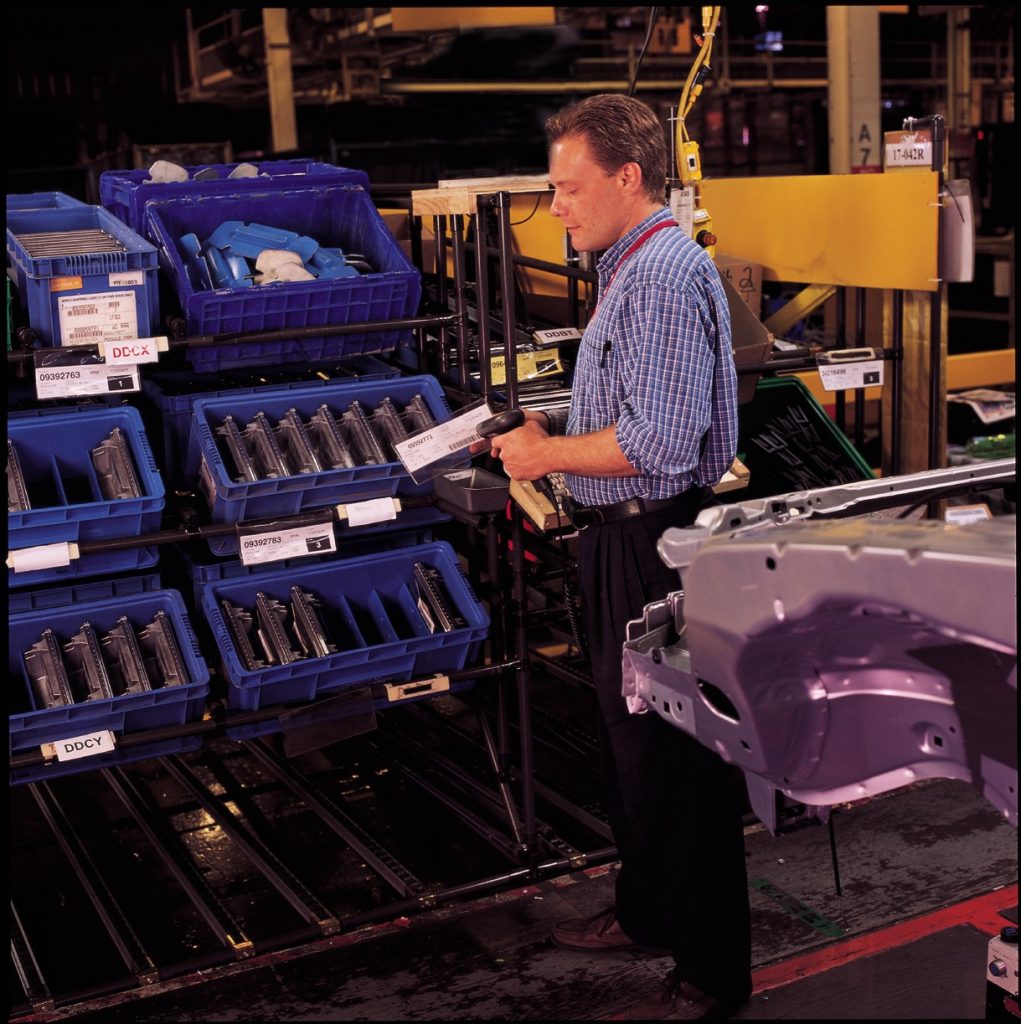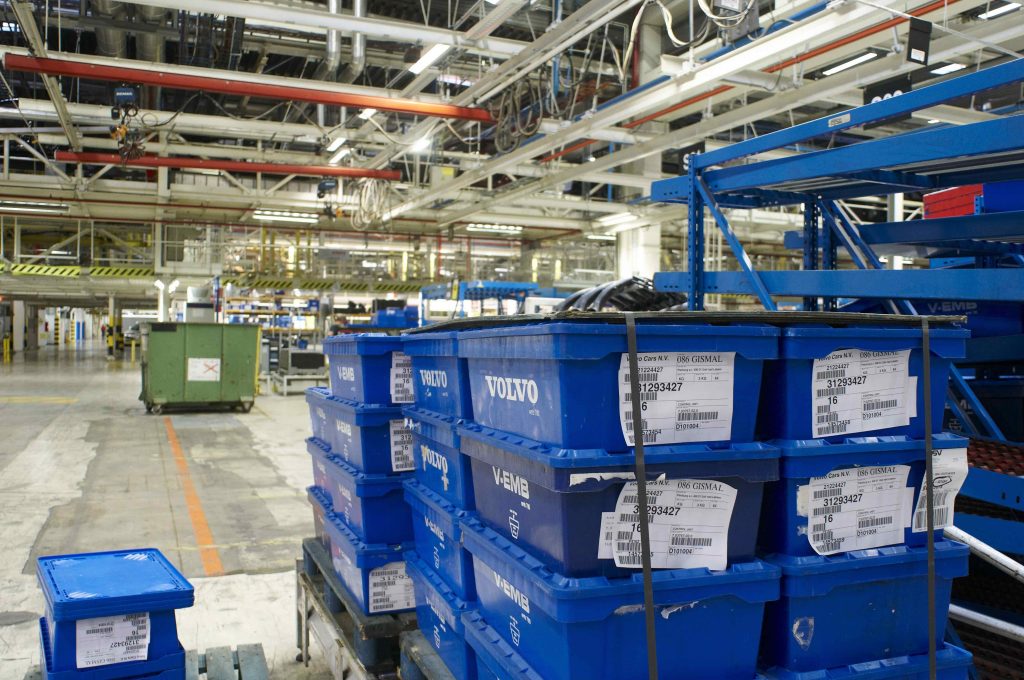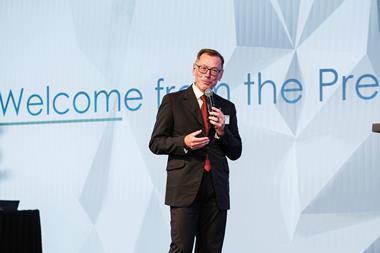 [sta_anchor id="1"]Tracking technology is playing an ever greater role in the effectiveness of returnable packaging, but still has some way to go before it becomes ubiquitous
[sta_anchor id="1"]Tracking technology is playing an ever greater role in the effectiveness of returnable packaging, but still has some way to go before it becomes ubiquitous
Tracking returnable containers, racks and pallets has come a long way during the past few years, and while barcoding is still the dominant technology, radio frequency identification (RFID) is gaining ground, albeit slowly, in the automotive sector.
A good example is set to begin in Mexico at Audi’s new factory, which will put RFID tags on all containers.
Container tracking technology is far from ubiquitous, however, and the automotive sector still uses many manual processes. There is also still a lack of interest in tracking containers, compared to the much greater focus on the automotive parts they hold. Packaging is simply not a core interest for many OEMs and suppliers.
This mindset is changing, however, thanks to greater transparency and the potential to save costs.
In North America, in particular, but also elsewhere, the potential gains are being amplified by a record returnable container build rate and growing cost pressures, which have driven a need for better utilisation of existing container stock.
“The automotive industry is beginning to realise the importance of packaging and of the hidden costs associated with a lack of control,” confirms Guido Lehnen, Chep Europe’s director of customer service, automotive and industrial solutions.
While the sector is focusing on technology trends like the ‘internet of things’ and the increasing value of built-in electronic components, asset tracking technology is gaining ground, he says. “Asset tracking is a trend that will always be on the rise... whether the customer finds value in tracking its containers, racks and pallets or rather using the tracking technology to provide information about the goods inside.”
Eric Swanson, director of project management at packaging provider Orbis, says the prevalence of just-in-time (JIT) deliveries has made containers’ value more critical. Yet not all containers need to be tracked in the same way, he points out. Tracking individual containers is more important in open loop systems – particularly in tier one-to-OEM flows. If a carmaker owns its containers, on the other hand, movement between the OEM and its suppliers tends to be more of a closed loop, in which case the OEM can use a ‘balance forward’ approach rather than using barcodes or RFID, he says.
In this story...
Increasingly, container tracking technology has become cloud or web-based, says Swanson, and there is also a proliferation of handheld devices to scan containers now, from dedicated handheld units to mobile phones.
[sta_anchor id="2"]Honda’s RFID pilotThough still far from dominant, RFID is an up-and-coming technology in terms of container tracking. One carmaker looking into it is Honda North America, which is searching for ways to improve its supply of returnable containers to tier suppliers, according to Dana McBrien, associate chief advisor for North America logistics.
“Our goals are also to ensure that our asset base is right-sized for the production conditions and to create an interchangeable asset pool across multiple Honda plants,” he says.
As the price of RFID has come down and the growing complexity of the supply chain has driven the cost of container management up, the break-even point of RFID is closer to reality for Honda, he reports. Despite this, the technology still needs to be proven.

Honda is about to attempt to do just that with plans for a trial of RFID technology that will start soon at one of its plants in central Ohio and at one large supplier, also in Ohio. “We chose a plant/supplier relationship with high complexity in their packs and high volatility in the parts supplied, in order to generate as much of a true-to-life network as possible,” says McBrien. “We are also using a manufacturing site close to our North America logistics offices, and an Ohio supplier, so that we can be ‘at the spot’ in a very short time for observations or problem resolution.”
Outside of this trial, the OEM uses a system that it developed itself together with an outside programming firm. It tracks different types of containers with its suppliers at a macro level, the purpose being not to track each individual asset, but to ensure Honda maintains the proper level of each container at each supplier, based on its production demand. Using order data to calculate the container balance and a theoretical inventory held at the supplier, Honda generates a daily pick list. “The challenge with this approach has been an inconsistent adoption of the processes at each of Honda’s sites and the fact that this technology is now more than 14 years old and has not grown with the complexity of our supply chain,” admits Bill Myers, staff administrator for the supply chain team at Honda’s North America logistics office.
Honda’s approach to making changes to its container tracking has centred on expanding the use of the technology it has in place and making incremental improvements to it. Its primary focus, McBrien explains, has been on providing better visibility tools for its logistics providers and suppliers for a better understanding of what has shipped and when it is likely to be received.
Honda has also been pursuing improved standards in conjunction with the Automotive Industry Action Group (AIAG) relating to the use of shipping labels and advance shipping notices (ASNs) for the delivery of empty returnable containers that are similar to those used to ship parts from suppliers to OEMs.
 While open loop systems call for more dedicated tracking, OEMs tend to use a ‘balance-forward’ approach for owned containers in more of a closed loop between their plants and suppliers
While open loop systems call for more dedicated tracking, OEMs tend to use a ‘balance-forward’ approach for owned containers in more of a closed loop between their plants and suppliers“Our quest for incremental changes using old technology has been difficult. We are seeing some improvements, but the complexity curve is much steeper than our innovation curve,” admits McBrien. “Although we are making strides in both packaging and logistics efficiency, they can quickly be absorbed by new loss due to complex conditions.”
In the current, macro-level data collection approach, container counts are maintained in a pallet-level shipping unit record and total container counts are contained within an ASN generated through the supplier – either by scanning a container label to capture the counts or by manually creating the counts where labels are no longer present. The fulfilment of Honda’s outbound container pick lists is primarily a manual process to identify the right container types and volumes.
Honda is hoping RFID will change all this, however. “We want better visibility of all of our assets as well as more real-time analytics to help make faster decisions,” says Bill Myers. “The lack of data today creates a very reactive environment. By the time we know the problem exists, the response must be immediate and [is therefore] sometimes costly.”
[sta_anchor id="3"]Growing technology capabilityImprovements in RFID technology, such as better read accuracy (now around 99%) and its integration with other technologies, make it more attractive for the job of tracking containers throughout a supply chain and helping to change the traditional mindset that RFID is only of real potential for high-value assets such as racks, suggests William Wappler, president of technology supplier Surgere.
Read accuracy has been particularly important, he suggests, adding that one of Surgere’s most important accomplishments in this respect has been its sRFID solution’s ability to accurately read a tag moving across a dock plate or in an area of about 9ft by 8ft (2.7 metres by 2.4 metres). Reading moving tags accurately in a tightly defined area has allowed the technology to be moved into other plant zones for purposes like inventory, other asset movements or storage visibility.
[sta_anchor id="4"]One high-profile supplier that has adopted RFID is Johnson Controls Inc (JCI), which nearly two years ago rolled out a passive tag system based on technology from Surgere and Smart Label Solutions.
Mark Klenczar, supply chain management (SCM) packaging engineering manager at the supplier, says its main objective was to achieve and maintain real-time visibility over its assets – in particular, tracking containers between its various plants and between plants and those of tier one suppliers. As a result, the company could ultimately get its container assets returned sooner and buy fewer for its fleet.
Deployment has involved the use of container-tagging teams at five chokepoints within North America, including one in Mexico, and the installation of RFID gate-readers at dock doors.
So far, says Klenczar, JCI has tagged about 870,000 returnable containers out its total of 4m-5m in North America. It will continue to tag containers as it launches new programmes, including a heavy launch within the next 12-18 months.
“Our priority is larger containers that present the greatest challenges – we use 90,000 of them daily,” he says. “For small totes, we have not seen a business case for tagging,” he admits.
JCI is using container tracking data to monitor slow-moving items, in particular. Another area of focus has been work-in-progress inventory. “Some containers are not supposed to leave the plant but they are still leaving; RFID provides us with visibility [over that],” says Klenczar.
He points to the benefits of knowing containers’ locations as well as their speed in the supply chain. “It also allows us to hold JCI’s internal and external facilities responsible for using specific containers only as planned,” he says. “If we send assets to external suppliers, we expect them to be returned in a timely manner. Internally, we expect them to be used for the right programme.
“If the packaging is used in another programme, the specialised dunnage may be removed, which would be a problem,” he points out.
The company is also contemplating the use of RFID for parts tracking, which will be brought in after the container programme has been expanded further and will involve linked use of barcodes and RFID tags.
JCI is also using container tracking to calculate the loading factor of trucks, as well as seeing how long it takes to go from one plant to another. “Full trailers move faster than empty ones,” Klenczar observes. “When containers are watched, the asset cannot sit around.”
There are other benefits that one might not expect. For example, Klenczar points to the fact that better visibility over packaging assets can eliminate the need for having to keep or procure backup expendable packaging in the event that containers go unaccounted for at critical moments. Likewise, there are labour and productivity savings possible across plants and warehousing.
“We find it reduces downtime that resulted from containers not being available on time,” says Klenczar.
Surgere is currently working with tier supplier Grupo Antolin in the design, build and testing of a new product for use in tracking, monitoring and managing road transportation, he reveals.
Surgere’s Aeris device, meanwhile, provides global visibility of assets after they leave the sRFID environment and can track a container anywhere in the world, reporting on attributes such as relative humidity, shock, vibration, light and temperature, says Wappler.
Tracking individual containers and parts in ways beyond the capability of a simple barcode is beginning to deliver tangible benefits, depending on the complexity of the supply chain and the value of the asset being tracked.
“Most customers almost expect RFID to be part of their packaging provider’s offerings. The question is whether the value outweighs the cost,” says Chep’s Guido Lehnen. “Automotive parts shippers want a system that can effectively support a JIT or JIS (just-in-sequence) system by ensuring zero downtime at or beyond lineside.”
RFID deployment remains at a very low level compared to the overall use of returnable transit packaging, however, admits Jörn Brosowsky, sales director for automotive at the Schoeller Allibert Group, based in Hoofddorp, the Netherlands.
“OEMs only use RFID in some small in-plant loops, but generally not to or from the plant,” he says. “Some exceptions are spare parts flows in which the supply of high-value goods must be monitored from the distribution centre to the dealership.”
Chep offers an installed RFID system for its IcoQube intercontinental reusable packaging as well as its foldable large container pool. Each container is equipped with two RFID tags and scanners and portals are installed at Chep’s service centres for tracking them. This allows it to improve asset control and reduce losses, in addition to tracking repairs and simplifying reconciliation.
Guido Lehnen points out, however, that the application of RFID for packaging goes beyond tracking the container. “If customers can follow their parts all the way through the supply chain, they can better understand dwell times and reduce pipeline inventory,” he suggests. It also helps validate data from providers such as ocean or road carriers, he adds.
Automotive customers include tier suppliers and OEMs that own expensive bespoke stillages, says Lehnen. Typically, these would be JIS suppliers delivering large parts to a line, and Chep would supply passive tags with handheld or gate readers in such applications.
RFID can also be used to trace high-value, highly sensitive or otherwise critical parts inside a container. Jörn Brosowsky of Schoeller Allibert says a popular solution in such applications involves multiple labels incorporating an RFID tag, a barcode and an alphanumeric number on the same container, allowing tracking via different technologies at different points in the supply chain.
Brosowsky explains why companies might pay for containers with multiple reading technologies built into them, but not use all of them. It is partly a function of the container pooling model, in which the pooling provider rents equipment to companies that use various types of readers. “With the multi-technology lavel, if the supplier wants to monitor the container and part, it can use the container tag,” he says.
“The cost to print the label is the same, although the RFID tag is extra. The industry mainly uses barcodes and hopefully within ten years it will be more involved with RFID. However, even though not all companies have RFID reading capabilities right now, there has been no backlash about the cost of the comprehensive tag.”
[sta_anchor id="5"]Rollout challengesThe main challenge in implementing RFID or any other new tracking technology is to get all of a supply chain’s partners involved to avoid gaps in the data, says Lehnen.
Brosowsky adds that the requirement for new reading equipment right across a supply chain can put some off using RFID, while achieving efficient exchange and use of all the data generated by it also remains a challenge, especially across different parties in the supply chain. Such challenges are still inhibiting its use for tracking standard returnable packaging flows, he admits.
“In general, barcodes or kanban cards are more likely than RFID to support in-plant full container flows,” he states. “In contrast, RFID is in wider use by logistics and pooling providers for whom container management and container service – for example, repair, cleaning and maintenance – are a vital element of their business models.”
Perhaps not surprising, then, that some of the biggest OEMs continue to use other means for managing their returnable packaging flows. General Motors, for example, is implementing the first phase of a new system to track its container shipments, receipts and inventory levels, reports Renee Wawrzynski, director of global logistics planning. The plan is to increase the visibility of containers in transit, ensure timely returns by logistics providers and monitor container inventory at the part suppliers, she says.
 According to Schoeller Allibert, RFID is mostly used right now in small in-plant loops, with some exceptions for high-value spare parts that must be monitored from distribution centres to dealers
According to Schoeller Allibert, RFID is mostly used right now in small in-plant loops, with some exceptions for high-value spare parts that must be monitored from distribution centres to dealers“This phase is the scheduling system, which ties into the material requirements planning (MRP) system. It determines how many containers to ship by looking at supplier needs and the number of containers unique to each type. It will use labels containing barcodes that indicate the parts supplier from which it ships.
“Next year, we will implement Phase II, which will focuson inventory management, including in-transit containers,” she adds.
GM is working to reduce its back-up expendable packaging costs, container replacement costs and repack costs from expendable to returnable. It also wants to reduce premium transport costs – for example, where there is a container shortage and it cannot use cardboard but still has to expedite a particular shipment.
GM also wants road transport firms to help it track containers, says Wawrzynski. “We need carriers to support our efforts by engineering and managing the return of empty containers, and by implementing GPS tracking devices on their trailers to provide us with visibility,” she explains. “There is a lot of tracking of the driver and tractor but we need to know the trailer location. Dropped trailers may sit for days. Carriers do not manage that well. We are also tracking the transit times to return our containers.”
GM does not use RFID tags on its containers, however. “We do not have significant concerns about knowing where empty containers are within our facilities; the problems occur after containers leave the plant,” Wawrzynski explains. Passive RFID tags will only show a container’s most recent scan point, and although active RFID tags can show actual container location, they have limited battery life and tracking them down to replace the battery can be quite involved.
Wawrzynski says GPS or Bluetooth seem like more efficient technology solutions and that GM is now waiting for these to become more economical.
Proof, perhaps, that while RFID’s role in managing returnable packaging is certainly growing, there are still a number of ways for OEMs and tier suppliers to think outside of the box when it comes to tracking their containers.





































